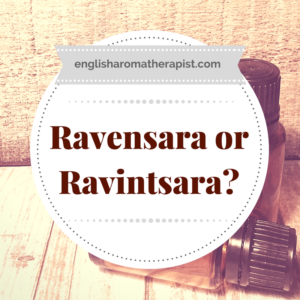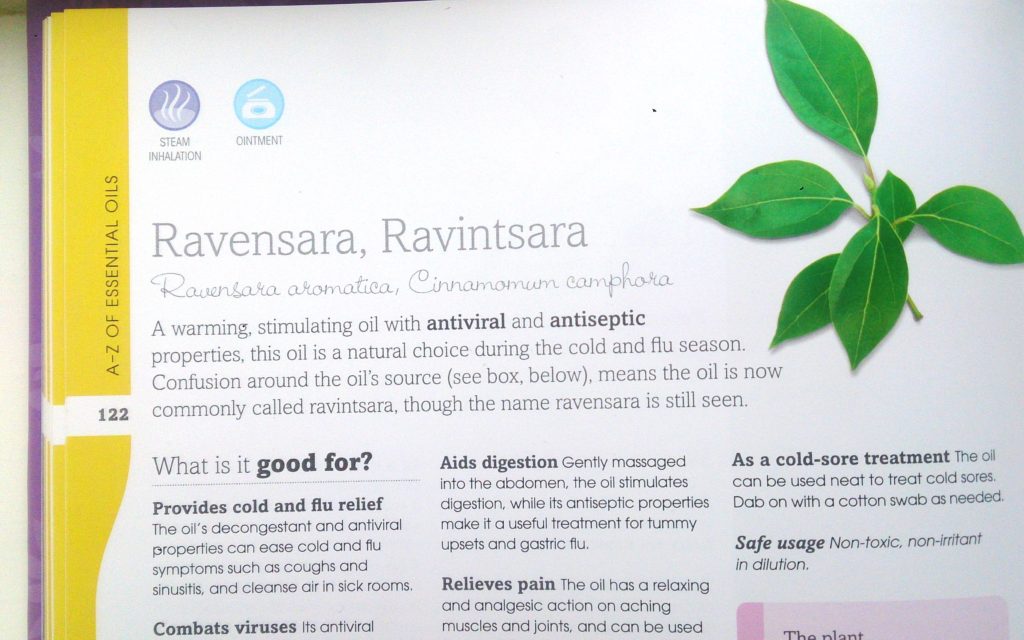Ravensara or Ravintsara?

I’ve been asked quite a few times about the difference between Ravensara and Ravintsara. There is, understandably, some confusion about these similarly-named oils – not helped by the fact that some websites and books even confuse the names!
This has been written about before, and I certainly do not intend to tread on anyone’s toes – but I thought it was worth mentioning again, simply due to the amount of misinformation that I have encountered during my research.
Not the same
Despite some claims, Ravensara and Ravintsara are not the same essential oil!
Ravensara (Ravensara aromatica) and Ravintsara (Cinnamonum camphora) are completely different essential oils.
Some sources claim that Ravensara is the “old name”, and that the oil is now more commonly known as Ravintsara. Sometimes the therapeutic properties of one are transferred to the other, as if they are interchangeable.
Websites will often list an oil as “Ravintsara (Ravensara)” – as if Ravensara is merely a synonym for the same oil. I have also seen Ravensara listed for sale with the Latin name “Cinnamomum camphora”.
The amount of inaccurate and misleading information about Ravensara and Ravintsara is incredible.
A recently published book (see below) lists both oils together on a joint profile, advising that the unspecified Ravensara/Ravintsara can be used neat on cold sores – rather irresponsible advice, once you consider that the recommended maximum dermal limit for Ravensara leaf oil is just 1%, according to Essential Oil Safety (2014) by Tisserand & Young (and a tiny 0.1% for Ravensara bark oil).

Ravensara and Ravintsara have grown in popularity over recent years. Most essential oil brands appear to stock one, but not the other (although I noticed Eden’s Garden stocks both). Ravintsara is also known as Ho Leaf (cineole chemotype).
Wikipedia states that “the name ravensara is a latinization of the Malagasy word ravintsara” (Malagasy is the national language of Madagascar, from where Ravensara originates). This has led to the assumption that the two terms are interchangeable, rather than representing completely different plants.
The confusion is compounded by the fact that the pronunciation of Ravintsara and Ravensara is virtually identical!
What’s the difference?
Both oils belong to the Lauraceae family and are recommended for respiratory conditions, viruses, immune support and muscular aches.
While they offer similar therapeutic properties, Ravensara and Ravintsara actually have significantly different chemical constituents.
And, just when you thought it couldn’t get any more confusing, there are different chemotypes of Ho Leaf that have their own individual chemical profiles. For example, Ravintsara (ct. cineole) has a high level of the chemical compound 1,8-cineole (Eucalyptol). Some sources mistakenly describe Ravensara as being high in 1,8-cineole, when it actually contains very little.
Safety
Ravensara should be used with caution as it contains a chemical constituent known as methyl chavicol (estragole), which is a potential carcinogen. Although it can be extracted from the bark, the oil from Ravensara leaf is more commonly used in aromatherapy as it contains a much lower percentage of methyl chavicol. Ravensara bark oil is not recommended for general therapeutic use.
The linalol chemotype of Ho Leaf has fewer safety precautions than the camphor and cineole types.

Ravensara Leaf
Latin name: Ravensara aromatica
Botanical family: Lauraceae
Scent: Camphorous, medicinal, sweet, woody, similar to Eucalyptus
Uses: Arthritis, depression, fungal infections, immunity, muscular aches, respiratory conditions, rheumatism
Safety: Maximum dermal limit of 1%, according to Essential Oil Safety (2014) Tisserand & Young
Ravintsara/Ho Leaf
Latin name: Cinnamomum camphora
Botanical family: Lauraceae
Scent: Earthy, woody, camphorous, similar to Rosewood
Uses: Anxiety, arthritis, depression, fungal infections, immunity, insomnia, muscular aches, respiratory conditions, stress
Safety: No specific precautions for Ho Leaf (ct. linalol), according to Essential Oil Safety (2014) Tisserand & Young. However, Ravintsara/Ho Leaf ct. cineole should not be used near the face of young children, and has a recommended maximum dermal limit of 11%.
Summary
Be aware of which essential oil you are using – if in doubt, always go by the Latin name. Ravensara and Ravintsara have their own individual safety precautions and should be treated as separate oils, not as “one and the same”.
For the avoidance of confusion, consider using the term Ho Leaf, rather than Ravintsara, as an easier way to differentiate the oil from Ravensara.
Further reading
http://www.naturesgift.com/aromatherapy-information/how-to-use-essential-oils/ravensara-ravintsara/
https://aromaticstudies.com/ravintsara-vs-ravensara-whats-the-difference/
http://roberttisserand.com/2010/02/ravensara-rant/
http://materiaaromatica.com/Default.aspx?go=Article&ArticleID=187
What to Read Next:
Quick Answers to Common Myths
Follow me on...
Share this on...
